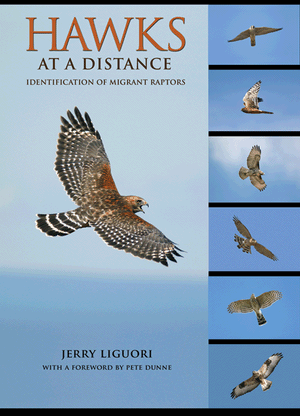Standing atop Lucky Peak, on the east end of the Treasure Valley, overlooking the city of Boise, I got my first taste of hawk-watching. There the crew of the Idaho Bird Observatory counts hawks in migration. I was amazed and very impressed at the skills of these college aged "kids". They could call out an identification of a bird of prey a mile away. "How do you do that?" I exclaimed! Identification, for these young but experienced hawk-watchers, was the easy part. The ability to explain to me how they knew the bird was the hard part. Jerry Liguori has found a way to communicate to birders of all ages and skill levels how he can identify hawks at a distance. He provides us with a study tool that is the next best thing to being with him atop a ridge near a hawk flyway.
Having just reviewed the Crossley Guide, I can't help but notice a strong similarity in the method and instructions on how to use "Hawks at a Distance". It really is a study guide, not a typical field guide. Each species has its own section that starts with a stunningly beautiful close-up photo and some text, but then right away gets down and dirty with dozens of distance photographs. All of the photos are nicely scaled to a consistent size for ease of comparison and they really do look like what you see through your binoculars. Ligouri captures all the lighting and angles in which you could possibly see these hawks.
In one evening, I pretty much read the entire book. Now I'll have to go back and study each species. I am so delighted with the all of the new identification clues I have found herein that I have not come across in any other writings on hawks; not only clues about the birds themselves, but how to look at them. I appreciate the bold font highlighting key points of wisdom. The forward by Pete Dunne is excellent and sets a great tone for what is to follow. The "Shape Guide" in black and white in the back is a fantastic learning tool helping you focus on shape as well as the light and dark contrast rather than on the color. It should be noted that this guide is about hawks at a distance in flight, not perched.
If you've struggled with the Accipter identification malady like I have, Hawks at a Distance is the cure. By putting in the work to study these photos and internalizing the helpful text explaining what is shown in each photo, you would be ready to join a hawk-watch group and dazzle them with your advanced skills. Next time I visit a hawk-watch site, I'll be ready, thanks to "Hawks at a Distance!"
Having recently moved to Utah, I've been privileged to read Jerry's blog posts at Utah Birders.
For samples of the book, visit the links below:
Cooper's Hawk
Red-shouldered Hawk
Rough-legged Hawk
I wish to express my continued thanks to Princeton University Press for providing me with review copies of wonderful birding books. You can purchase a copy of "Hawks at a Distance" from their website or on Amazon


Wonderful review! I will definitely have to look into "Hawks at a Distance" as I have great difficulty identifying these magnificent birds.
ReplyDeleteI have "Hawks from Every Angle" by the same author. It's been a great resource for me here in Alberta. I would be curious to know how similar this book is to that publication?
ReplyDeleteI just got "Hawks at a Distance" and I think it complements "Hawks From Every Angle" very well. The two books are similar (well, they are both about Hawk ID) but this new book has color photos of all the species in all types of light and not one of them is close-up (except the beautiful portraits that open each section). It is a hawkwatcher's dream guide! The text is concise as it gets, but highlights key points perfectly. It really is a neat little book. I find Liguori's guides and "Hawks in Flight" much more useful than Wheeler and Clark guides that just show up close pictures.
ReplyDeleteThanks for the review Robert, and glad you like the book! My goal in writing it was to present raptors the way they are normally seen. It isn't a portrait book (although I love portraits and showed one for most species just for "looks"), and was a bit scary to approach. I figured, if I was happy with it, that was the best I could do and just hoped others appreciated it. The fact that you said you found things in the book you haven't seen published before is a great compliment....and I think that is in part because birds aren't often written about from a "distant" perspective.
ReplyDeleteI also wanted to share how I look at birds and what I personally think are the most accurate traits to use in the field...I think the INTRO sums that up. Anyway, we'll have to get out this spring or fall and try to put names to some real hawks.
Cheers, and many hawks,
Jerry Liguori
@Julie G. - thanks for the comment. It really is a useful tool for learning hawks.
ReplyDelete@David @Michael F - Thanks for the comments. I am sure Jerry Lig will appreciate your kind words.
@Jerry - I'm glad to join you as a Utah Birder. Thanks for the effort in putting your amazing books together. I look forward to watching hawks with you.
Robert:
ReplyDeleteHope you can find me on a mountain top -- I'm a bit of a hermit these days doing most of my hawk watching alone. Haven't been back East in almost 15 years but still traumatized from it...know a good therapist?
Of course the last comment was just half-joking. I might do a hawk watching day in April with a bunch of people, I'll let you know if it happens...will be fun
ReplyDeleteJerry